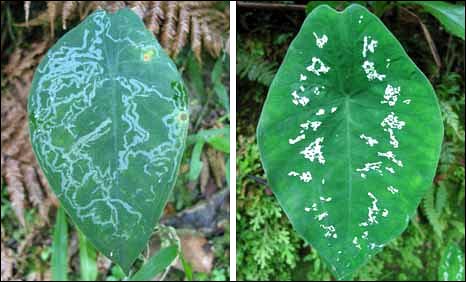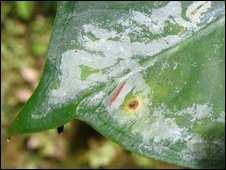|
Matt Walker
Editor, Earth News
|


A leaf damaged by mining moths (left) compared to one faking it (right).
A plant that pretends to be ill has been found growing in the rainforests of Ecuador. The plants feigns sickness to stop it being attacked by insect pests known as mining moths, which would otherwise eat its healthy leaves. It is the first known example of a plant that mimics being ill, and could also explain a common pattern seen on plant leaves known as variegation. The discovery is published in the journal Evolutionary Ecology. Variegation is familiar to gardeners and affects many species of plant. Variegated plants have different coloured patterns on the leaf surface, produced by a variety of causes. One of the most common is when cells in the leaf lose chlorophyll and their ability to photosynthesise, appearing white. In theory, plants with variegated leaves should be at a disadvantage, because of this restricted ability to photosynthesise. But a chance discovery by a team of botanists suggests this may not be true after all. Instead, some variegated plants may be mimicking illness to avoid being eaten, putting themselves at an advantage.
Sigrid Liede-Schumann and colleagues Ulf Soltau and Stefan Dotterl of the University of Bayreuth in Germany were studying understory plants in the forest of southern Ecuador, when they noticed that the plain green leaves of a plant known as Caladium steudneriifolium were far more frequently damaged by mining moths than those of variegated leaves of the same species nearby. Mining moths lay larvae into the leaves, and the caterpillars then munch through the leaf surface, leaving a white trail of damage behind. "The similarity of the variegation patterns with the criss-cross munching traces of the larvae led to the idea that maybe they deter the mining moth from laying its eggs," says Liede-Schumann. To test the idea, the researchers used white correction fluid to mimic the appearance of variegation on hundreds of healthy leaves. After three months, they then counted the number of leaves affected by the mining moth caterpillars, comparing green leaves, variegated leaves and those painted white to appear variegated.

A mining moth caterpillar leaves a trail of damage.
|
"The results were the same," says Liede-Schumann. "Visibly variegated leaves were significantly less frequently damaged by mining moth larvae than plain green ones." While moths infested almost 8% of green leaves, they infested 1.6% of variegated ones and just 0.4% of those painted to look like they were variegated. "I was quite surprised," says Liede-Schumann. She believes that the plant essentially fakes being ill, producing variegated leaves that mimic those that have already been damaged by mining moth larvae. That deters the moths from laying any further larvae on the leaves, as the insects assume the previous caterpillars have already eaten most of the leaves' nutrients. "The fact that there are both plain green and variegated leaves in the population indicates to me that both are useful in the long-term success of the species," says Liede-Schumann. The reduction in a variegated leaf's ability to photosynthesise is likely to be more than offset by the benefits of not being eaten, the researchers believe, suggesting that variegation survives in wild plants because it confers a selective advantage.
|
~RS~q~RS~~RS~z~RS~49~RS~)
~RS~q~RS~~RS~z~RS~49~RS~)
Bookmark with:
What are these?